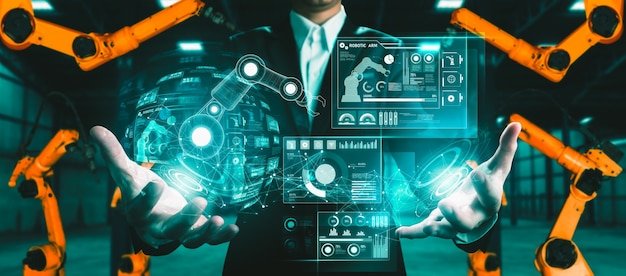In the evolving landscape of digital transformation, 2025 marks a pivotal year where enterprise hyperautomation systems are no longer a futuristic vision but an operational necessity. As organizations strive for agility, efficiency, and resilience, hyperautomation has emerged as the cornerstone of enterprise-level modernization. By combining robotic process automation (RPA), artificial intelligence (AI), machine learning (ML), and advanced analytics, hyperautomation is revolutionizing how large businesses operate, innovate, and compete.
What Is Hyperautomation?
Hyperautomation is the smart use of several automation technologies to make all parts of a business process run more smoothly. Hyperautomation tries to automate complicated workflows across departments and systems. This is different from standard automation, which focuses on single tasks that need to be done over and over again.
Enterprise hyperautomation systems are at the heart of this trend. These systems offer scalable platforms that can combine different technologies, such as AI-powered bots, data orchestration tools, decision engines, and analytics dashboards. Together, these systems cut down on the need for human input, lower the number of mistakes made, and make business processes faster and smarter.
The Driving Forces Behind Hyperautomation in 2025
Several key trends are propelling the adoption of hyperautomation in 2025:
- Workforce Evolution: As hybrid work models become the norm, enterprises need intelligent automation to support dispersed teams and digitize manual workflows.
- Data Explosion: With massive volumes of unstructured data flowing into enterprises daily, hyperautomation enables faster data interpretation, extraction, and action.
- Competitive Pressure: In a saturated market, enterprises must deliver faster, more personalized services. Automation accelerates innovation cycles and shortens time to market.
- Cost Optimization: Economic uncertainty and inflation pressures are pushing businesses to cut costs without compromising productivity—something hyperautomation achieves with precision.
How Enterprise Hyperautomation Systems Are Being Used
Across industries, enterprise hyperautomation systems are unlocking new levels of efficiency. Here are a few impactful applications:
1. Finance and Accounting
In finance departments, hyperautomation handles invoice processing, fraud detection, reconciliations, and compliance reporting. AI-driven systems read, validate, and process thousands of financial documents in seconds—tasks that previously took days or weeks.
2. Customer Service
Businesses are using robots that are combined with AI and natural language processing to help customers 24 hours a day, seven days a week. These bots not only resolve common queries but also escalate complex issues to human agents, ensuring better customer experiences while reducing service costs.
3. Supply Chain Management
Hyperautomation platforms predict supply disruptions, automate procurement, and optimize inventory management. AI models look at both old and new data to make predictions that are more accurate and help people make quick decisions across global supply chains.
4. Human Resources
From onboarding to offboarding, HR departments benefit from automated document management, compliance checks, and employee engagement workflows. Enterprise hyperautomation systems help HR teams deliver faster, more accurate, and more consistent services.
5. IT Operations
IT teams use hyperautomation to detect anomalies, respond to system alerts, automate patch management, and handle routine service desk tickets—freeing up valuable time for innovation and strategic projects.
Benefits for Enterprises in 2025
The adoption of enterprise hyperautomation systems is delivering measurable gains across several dimensions:
- Increased Efficiency: Automating complex, cross-functional workflows minimizes delays and manual errors.
- Scalability: Enterprises can rapidly scale operations without a proportional increase in workforce or infrastructure costs.
- Improved Accuracy: AI-driven decisions reduce human error in data processing and compliance-heavy tasks.
- Faster Decision-Making: Real-time analytics and automation tools deliver actionable insights that accelerate business decisions.
- Enhanced Customer Satisfaction: Automation ensures consistent, personalized, and faster service delivery.
Challenges and Considerations
Despite its benefits, implementing enterprise hyperautomation systems comes with its own set of challenges. These include:
- Integration Complexity: Merging old legacy systems with new automation tools requires careful planning and execution.
- Change Management: Ensuring workforce readiness and acceptance of automation-driven workflows is crucial.
- Security and Compliance: Automation must be governed carefully to maintain data privacy and regulatory compliance.
- Skilled Talent: There’s a growing demand for professionals who can design, manage, and optimize hyperautomation environments.
Looking Ahead
As we progress through 2025, hyperautomation is set to become even more intelligent, autonomous, and impactful. Innovations in generative AI, digital twins, and real-time process mining will push enterprise hyperautomation systems beyond efficiency into the realm of predictive and adaptive operations.
Organizations that invest now in building robust hyperautomation frameworks will be better equipped to navigate disruptions, scale sustainably, and maintain a competitive edge in an increasingly digital economy.
Conclusion
Hyperautomation is no longer a trend—it’s a transformation. Enterprise hyperautomation systems are reshaping how businesses think, act, and deliver value. By automating not just tasks but entire business ecosystems, enterprises in 2025 are setting new benchmarks for innovation, speed, and resilience in the digital age.
